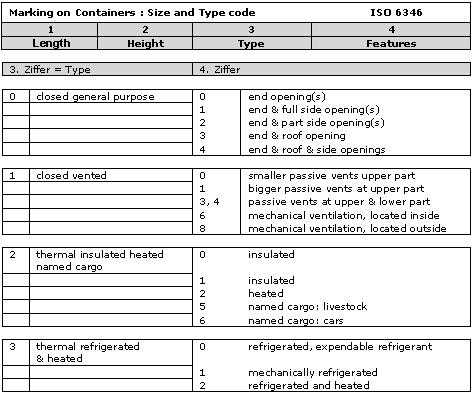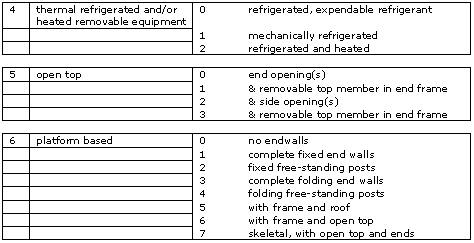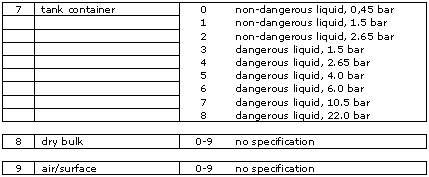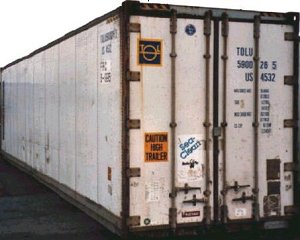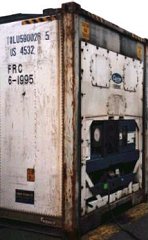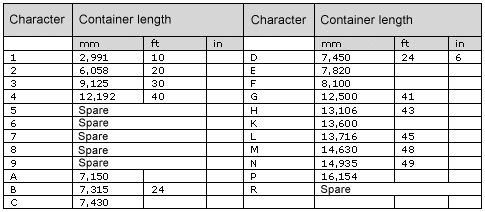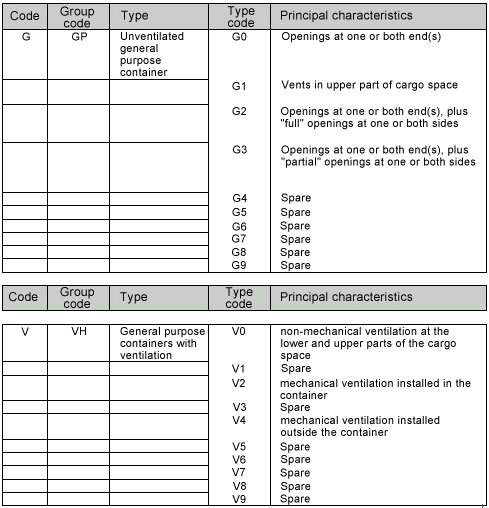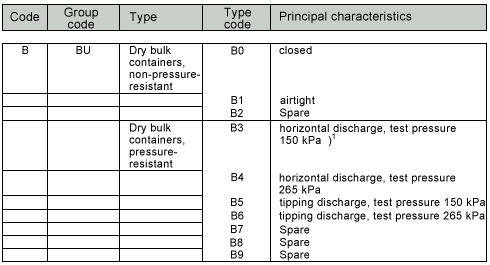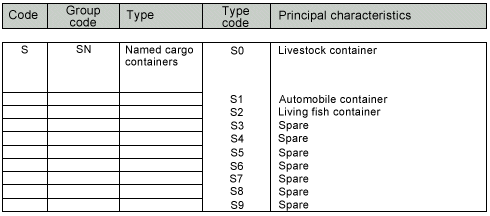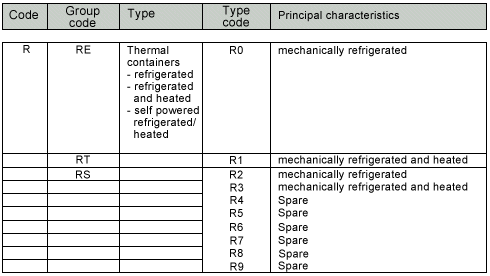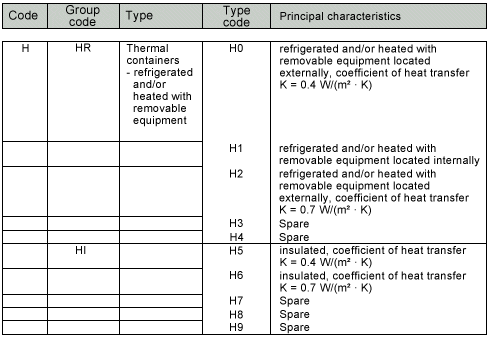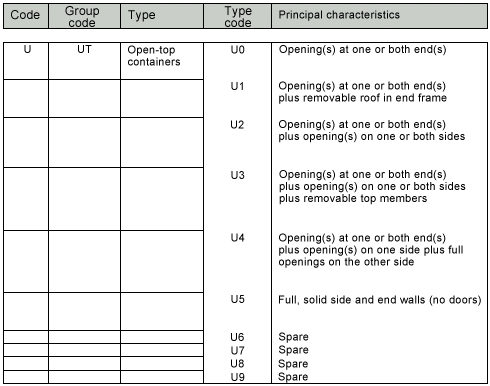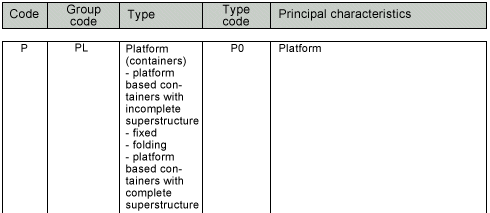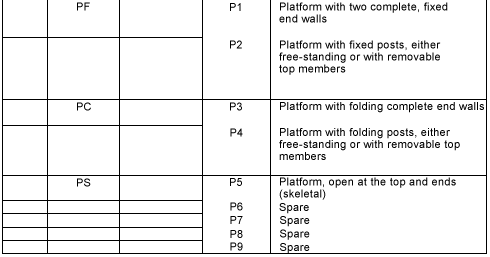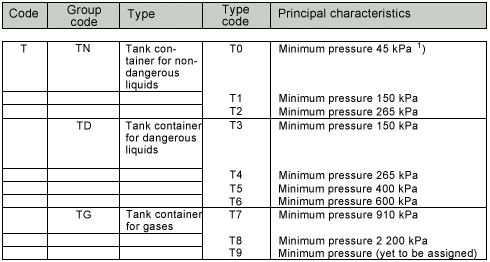The following photo shows a variant of horizontal marking which additionally includes country, size and type codes (in accordance with the 1985 version of DIN ISO 6346, use of which is still permitted):
 |
 |
| |
| Container identification including country, size and type codes |
Appropriate abbreviations are used for the various countries, here US for United States of America, GB for Great Britain etc.
The first digit of the size code indicates the length of the container, with the number 4 standing for a 40' container. The second digit indicates height and whether or not a gooseneck tunnel is present. In our example, the number 3 stands for a height of 8 foot 6 inches (8'6") with gooseneck tunnel. The first digit of the type code indicates container type. Here, 1 means that the container is a closed container with ventilation openings. The second digit of the type code relates to special features. The 0 used here means opening at the end.
In the associated standard, columns are set out vertically:
The corresponding data are laid out underneath. The abbreviation g.n.t. stands for gooseneck tunnel. A differently laid out size code summary is shown below:
In the type code, the first digit (i.e. the 3rd digit overall) indicates the container type and the second (i.e. the 4th digit overall) indicates special features. However, there is a connection between the respective digits, which the following representation is intended to explain:
 |
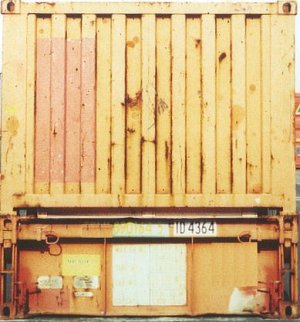 |
Incorrectly marked platform container |
The digit sequence 4364 means: 40' long container 8'6" high with gooseneck tunnel and folding, free-standing posts. It should carry the digit sequence 4363, since the platform container has complete, folding end walls.
Here are some examples of marking in accordance with this older standard:
 |
This container is 40' long (4), 8'6" high and has a gooseneck tunnel (3). The type code 00 states that it is a general purpose container which has opening(s) at one or both end(s). |
 |
This container is 20' long (2) and 8' 6" high (2). It is a ventilated standard container (1), with narrow, passive vents in the upper part (0). |
 |
This container is 40' long (4), 8'6" high and has a gooseneck tunnel (3). It is a ventilated standard container (1), with narrow, passive vents in the upper part (0). |
| Both of these are 20' containers (2), 8'6" high and constructed as tank containers (7) suitable for transporting hazardous materials to a pressure of 6.0 bar. |
 |
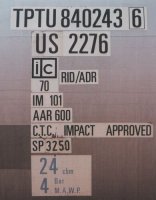 |
According to the old Annex F "size code designations" annexed to DIN ISO 6346 of August 1985, the two containers are 40' long (number 4) and 8'6" high with a gooseneck tunnel (number 3). According to Annex G "type code designations", both containers are partially ventilated closed containers, which have passive vents in the upper part of the cargo space, the total cross-sectional area of the vents being less than 25 cm² per meter of container length (number combination 10).
However, the coding does not indicate that the green container is 2.50 m wide.
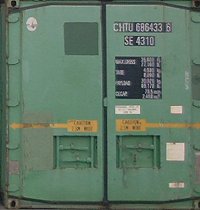 |
Below:
Warning due to
2.50 m width |
 |
The January 1996 edition of the standard bearing the same number includes another "size code", which has eradicated these inadequacies.
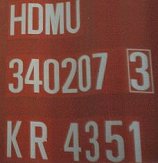 |
Like the above containers, this container is 40' long, 8½' high and has a gooseneck tunnel (number sequence 43). The type code 51 states that it is an open-top container, with openings at one or both end walls and a removable top member in the end frame. |
The number sequence 43 stands for a length of 40' a height of 8'6" plus gooseneck tunnel. In each case the container is a flatrack, but
... the number sequence 63 is the code for a platform with complete folding end walls |
 |
| ... and the number sequence 64 is the code with a platform with folding, free-standing corner posts. |
 |
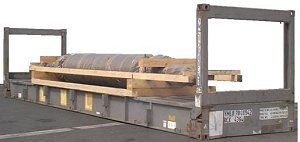 |
This flatrack allows verification of the coding, identification and marking according to old DIN EN ISO 6346 (1985), showing clearly that it is still valid, since the photo was taken in 2001. The marking beneath the container number reads RCX 4364. |
According to the old country code, RCX stands for China (Taiwan). The size code 43 states that it is a 40' container 8'6" high and with a gooseneck tunnel. The number combination 64 states that it is a platform with folding, free-standing corner posts.
| Similar flatracks exist which are 20' long and 8'6" high, of course, but they don't have goosenecks. This is clear from the number sequence 22. The type code 64 is the same as for the previous example: platform with folding, free-standing corner posts. |
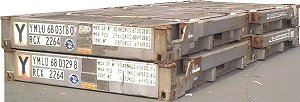 |
Both containers have a nominal length of 40', but are higher than 8'6" and each have a gooseneck tunnel (size code number sequence 45). According to type code 10, both containers are partially ventilated closed containers, which have passive vents in the upper part of the cargo space, the total cross-sectional area of the vents being less than 25 cm² per meter of container length.
 |
According to the old 1984 standard:
4 = 40' Container
5 = > 8'6" high with gooseneck tunnel
3 = thermal
2 = refrigerated & heated |
These photos show clearly that the container is a 40' long refrigerated container. According to the size code, the container height is > 8'6" - this is correct, as the container is 9½ feet high. The number combination 32, given as the type code, states that the container may be refrigerated or heated.
The following photo shows a variant of horizontal marking with size and type codes:
 |
 |
| Size and type codes additionally stated in accordance with current standard |
The container is 12,192 mm (40') long, 2,438 mm (8') wide and 2,591 mm (8'6") high. This is a general purpose container without ventilation, but which does have vents in the upper part of the cargo space.
The current standard, used for this marking, is not limited to numbers but also uses letters to make marking more precise. In addition, swap-bodies and the like are also covered by the coding. The superordinate term for both numbers and letters is character. The introductory country code has been discontinued.
The first character of the size code indicates the length of the receptacle:
In the example, the 4 accordingly stands for a 40' container.
The second character is the code for the height and width of the container.
The standard type code allows identification of container type and other characteristics. Since this system is not yet complete, the standard recommends use of the group code if special characteristics of the container type have not yet been fixed or are unknown. The highest unassigned code character should be used as a provisional mark when it is necessary to represent significant characteristics which are not yet included in the Table.
1) 100 kPa = 1 bar = 105 Pa = 105 N/m² = 14.5 lbf/in² (PSI)
1) 100 kPa = 1 bar = 105 Pa = 105 N/m² = 14.5 lbf/in² (PSI)
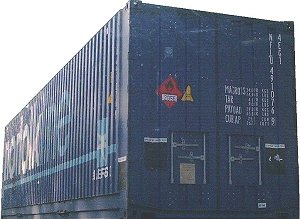 |
This Figure shows a variant of vertical container marking, with size and type code (on the left):
The identifying details are more or less clearly visible. |
| Vertical container marking |
Identifying mark plus
size and type codes
in horizontal arrangement |
 |
The container is 12,192 mm or 40' long (number 4 of first character of the size code). Its height is 2,895 mm or 9'6" and its width is greater than 2,438 mm or 8' and is less than or equal to 2,500 mm (letter E or second character of the size code). As regards type, the container is a general purpose container without ventilation, whose main characteristic is that it has vents in the upper part of the cargo space (characters G1 of the type code).
The owner code  and product group code and product group code  are also known as the alpha prefix. The check digit is often written in a box: are also known as the alpha prefix. The check digit is often written in a box:  . .
There now follows a number of examples of marking according to DIN EN ISO 6346, January 1996:
 |
According to the two characters 42 of the size code, the container is 12,192 mm or 40' long, 2,591 mm or 8'6" high and 2,438 mm or 8' wide. The type code characters G0 state that the container is a general purpose container without ventilation but with openings at one or both end(s). |
 |
 |
 |
| According to the two character combinations 22 and 42 of the size code, the container on the left is 6,058 mm or 20' long and the two containers on the right are 12,192 mm or 40' long. All the containers are 2,591 mm or 8'6" high and 2,438 mm or 8' wide. The type code characters G1 state that the container is a general purpose container without ventilation but with vents in the upper part of the cargo space. |
According to the two characters 22 of the size code, the container is 6,058 mm or 20' long, 2,591 mm or 8' 6" high and 2,438 mm or 8' wide. The type code characters P3 state that the container is a platform based container with folding complete end walls.
 |
According to the two characters 22 of the size code, the container is 6,058 mm or 20' long, 2,591 mm or 8' 6" high and 2,438 mm or 8' wide. The type code characters R1 state that the container is a thermal container which can be mechanically refrigerated and heated. |
| According to the two characters 28 of the size code, the container is 6,058 mm or 20' long, 1,295 mm or 4' 3" high and 2,438 mm or 8' wide. The type code characters P2 state that the container is a platform container with fixed posts, either free-standing (as here) or with removable top members. |
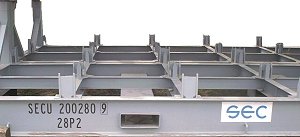 |
 |
 |
| According to the two characters 42 of the size code, the container is 12,192 mm or 40' long, 2,591 mm or 8'6" high and 2,438 mm or 8' wide. The type code characters U1 state that the container is an open-top container which may additionally be equipped with opening(s) at one or both end(s) plus removable top door rail in the end frame. |
According to the two characters 45 of the size code, the container is 12,192 mm or 40' long, 2,895 mm or 9'6" high and 2,438 mm or 8' wide. The type code characters G1 state that the container is a general purpose container without ventilation but with vents in the upper part of the cargo space. |
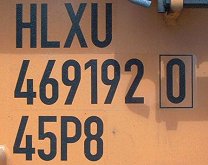 |
According to the two characters 45 of the size code, the container is 12,192 mm or 40' long, 2,895 mm or 9'6" high and 2,438 mm or 8' wide. The type code character P indicates that the container is a platform based container with complete end walls. The standard still gives type code P8 as being "spare". |
| Type code P8 has been used here for a "collapsible flat" (to the right), i.e. the end walls are collapsible for empty carriage. |
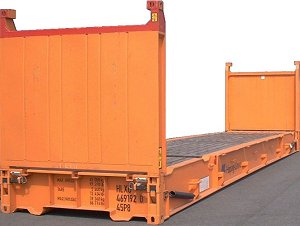 |
 |
According to the two characters 45 of the size code, the container is 12,192 mm or 40' long, 2,895 mm or 9'6" high and 2,438 mm or 8' wide. The type code characters R1 state that the container is a thermal container which can be mechanically refrigerated and heated. |
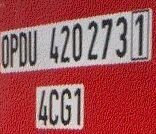 |
According to the character 4 of the size code, the container is 12,192 mm or 40' long. The character C indicates that the container has a height of 2,591 mm or 8' 6" and a width ranging between > 2,438 mm and < 2,500 mm. According to type code G1, the container is a general purpose container without ventilation, which nonetheless has vents in the upper part of the cargo space. |
 |
The character 4 stands for the length 12,192 mm or 40'. E states that the container has a height of 2,895 mm or 9' 6" and a width ranging between > 2,438 mm and < 2,500 mm. The type code characters G1 state that the container is a general purpose container without ventilation but with vents in the upper part of the cargo space. |
Given the large number of containers available today, it is impossible to tell how long the current codings will suffice and when more characters will need to be introduced.
|




